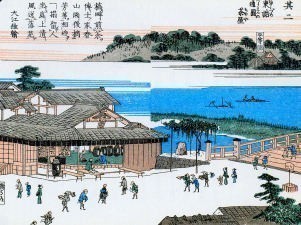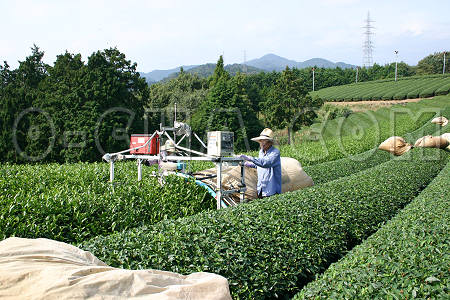About Green Tea
Where it Comes From
Although Japanese green tea is produced in many localities in Japan, the majority (43.9%) is produced in Shizuoka prefecture, located about an hour south of Tokyo by the bullet train. You can see some images of the actual fields where most of O-Cha.com's Shizuoka green tea is produced. If you are interested in how green tea is harvested and processed, we highly recommend you watch this Discovery Channel Green Tea Documentary featuring O-Cha.com staff in Shizuoka.
Uji Green Tea
 Another area famous in Japan for exceptionally high quality Japanese green tea is Uji (2.9%), not far from Kyoto. O-Cha.com carries quite a few Uji green tea products from several suppliers, including a number of items from Japan's oldest teas shop, Tsuen, located on the banks of the Uji River. Kagoshima Prefecture in Kyushu is another area which produces about 25% of the green teas that come from Japan. Kagoshima green tea is also known for its superior qualities.
Another area famous in Japan for exceptionally high quality Japanese green tea is Uji (2.9%), not far from Kyoto. O-Cha.com carries quite a few Uji green tea products from several suppliers, including a number of items from Japan's oldest teas shop, Tsuen, located on the banks of the Uji River. Kagoshima Prefecture in Kyushu is another area which produces about 25% of the green teas that come from Japan. Kagoshima green tea is also known for its superior qualities.
Types of Green Tea

There are quite a few varieties of Japanese green tea. A little knowledge here will help you choose quality product when it becomes time to make a purchase. Likewise, there are many ways to make green tea depending on the variety. If you are new to green tea, we recommend that you spend some time learning about each type and how to brew it correctly.
The main difference between the various Japanese green teas has to do with the way each is grown and or processed, the growing locality, and with the respective conditions imparting a different taste.
- Shading - Green teas grown under the full sun (sencha - 77%) versus those grown under the shade (gyokuro - 0.3%)
- Harvest - There are usually three or four per year, with the first considered to be the best quality. You will want to know which harvest your product comes from! In general, the earlier in the season the green tea is harvested, the better the quality. The very first harvest occurs near the end of April to early May, and is known as shincha, or in English as the first harvest or first flush.
- Powdered green tea - There are powdered versions of both sencha (powdered sencha) and gyokuro, they taste quite different. Matcha is superior to powdered sencha, but even here there are many quality levels. Be sure to read more about matcha before making a purchase.
- Bancha (9.8%), a late harvest green tea. Since the quality of late harvest green teas are lower than the first harvest, it is often this is used to make some other unusual types of green tea such as genmaicha (which has puffed rice mixed in with it), and another type known as houjicha, which is baked and produces a reddish color liquor with little to no caffeine.
- Sencha is grown in full sun, while Gyokuro is grown in the shade. Kabusecha is also grown in the shade, but not to the same degree and length of time as gyokuro, giving it a taste somewhere between the two.
- Shincha or "new tea" in Japanese, is that green tea which comes from the very first harvest of the of the growing season and which also is not put into cold storage but is instead immediately packaged and released for sale. Shincha is only available from May ~ July or as supplies permit. It tends to be expensive, as it contains the highest vitamin and poly phenol contents.
Steaming
One way to classify green tea is by how long it was steamed. Steaming takes place soon after the leaf reaches the factory (usually within a few hours). It's main purpose is to inhibit oxidization of the tea leaves. Fukamushi sencha, or fukamushi-cha, is sencha which is steamed for a longer than normal period of time during it's processing. This green tea is often grown at lower elevations. An expert tea grower will steam his tea according to the right conditions for each individual yield, and much knowledge and experience is required in order to adjust it just right. Fukamushi-cha tends to have a thicker, cloudy consistency and the loose leaf is finer.
Quality Levels
Like most things in life, higher quality green tea usually costs quite a bit more than lower quality products. Teas from the first harvest will cost more than later harvests. The amount of labor put into producing a given tea will also affect it's price. For example, in the case of gyokuro the tea plants need to be put under 90%+ shade for three weeks prior to harvesting. This involves building structures over the plants - more labor. Thus, gyokuro is usually quite a bit more expensive than sencha. Take those same shade grown leaves and turn them into matcha and the price will go up further. A really superb, high quality Japanese green tea will never really be cheap. Here are a few important things for a consumer to keep in mind when purchasing green tea: Which harvest the tea came from. The first harvest is always the best. Freshness. Green tea doesn't stay fresh as long as other types of teas and has a *great* impact on quality levels. Packaging. This relates to the above. Higher quality green teas are packaged so that hey do not oxidize. Taste. Some green teas, even when in comparable categories, simply taste better than others due to how they were grown.
How Japanese Green Tea is Produced
Green tea is produced in a number of ways, depending on which harvest the tea came from and what the final product is desired. Here, we provide an overview of green tea processing, or you can see it in action on our YouTube Green Tea Channel.

